The Intel NUC8i7HVK (Hades Canyon) Review: Kaby Lake-G Benchmarked
by Ganesh T S on March 29, 2018 1:00 PM ESTPerformance Metrics - I
The Intel NUC8i7HVK (Hades Canyon) was evaluated using our standard test suite for small form-factor gaming PCs. Not all benchmarks were processed on all the machines due to updates in our testing procedures. Therefore, the list of PCs in each graph might not be the same. In the first section, we will be looking at SYSmark 2014 SE, as well as some of the Futuremark benchmarks.
BAPCo SYSmark 2014 SE
BAPCo's SYSmark 2014 SE is an application-based benchmark that uses real-world applications to replay usage patterns of business users in the areas of office productivity, media creation and data/financial analysis. In addition, it also addresses the responsiveness aspect which deals with user experience as related to application and file launches, multi-tasking etc. Scores are meant to be compared against a reference desktop (the SYSmark 2014 SE calibration system in the graphs below). While the SYSmark 2014 benchmark used a Haswell-based desktop configuration, the SYSmark 2014 SE makes the move to a Lenovo ThinkCenter M800 (Intel Core i3-6100, 4GB RAM and a 256GB SATA SSD). The calibration system scores 1000 in each of the scenarios. A score of, say, 2000, would imply that the system under test is twice as fast as the reference system.

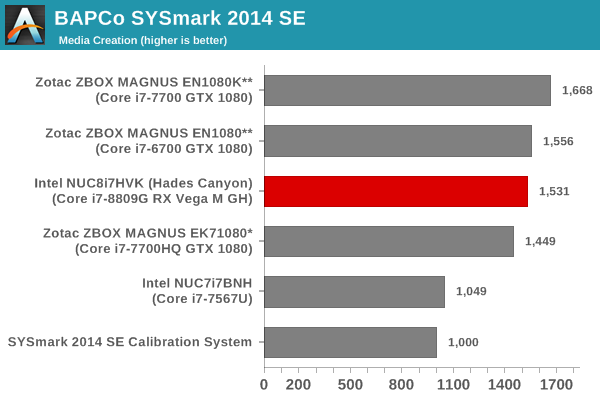

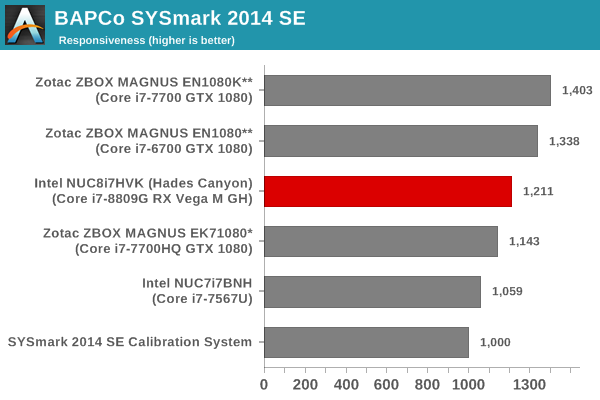
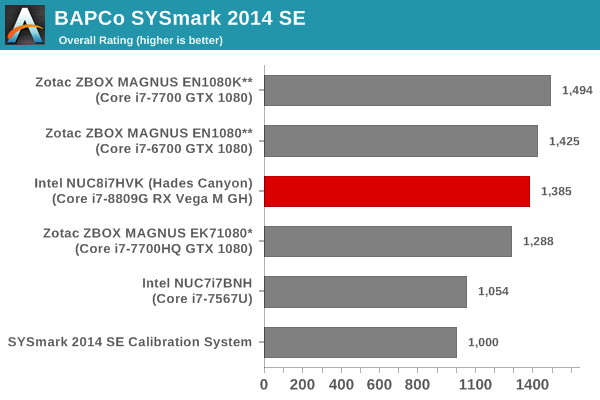
SYSmark 2014 SE also adds energy measurement to the mix. A high score in the SYSmark benchmarks might be nice to have, but, potential customers also need to determine the balance between power consumption and the efficiency of the system. For example, in the average office scenario, it might not be worth purchasing a noisy and power-hungry PC just because it ends up with a 2000 score in the SYSmark 2014 SE benchmarks. In order to provide a balanced perspective, SYSmark 2014 SE also allows vendors and decision makers to track the energy consumption during each workload. In the graphs below, we find the total energy consumed by the PC under test for a single iteration of each SYSmark 2014 SE workload and how it compares against the calibration systems.
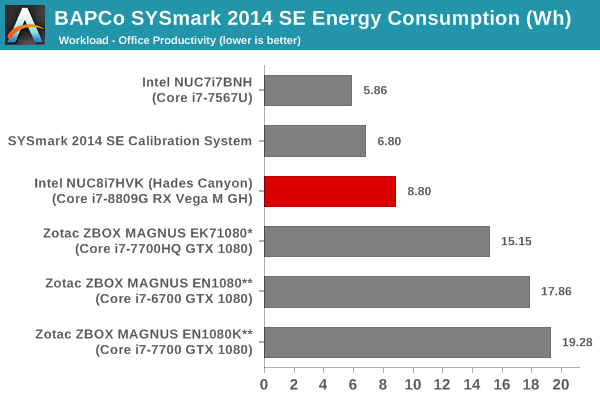
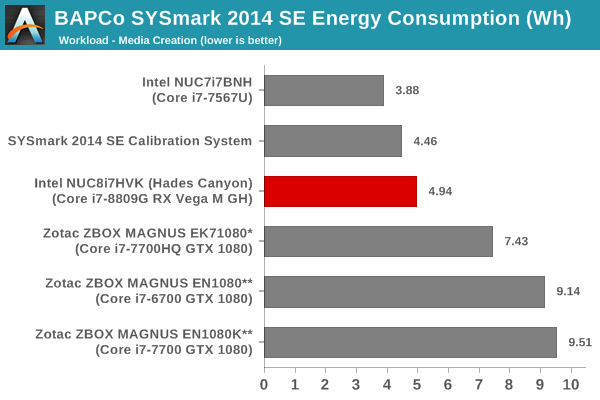
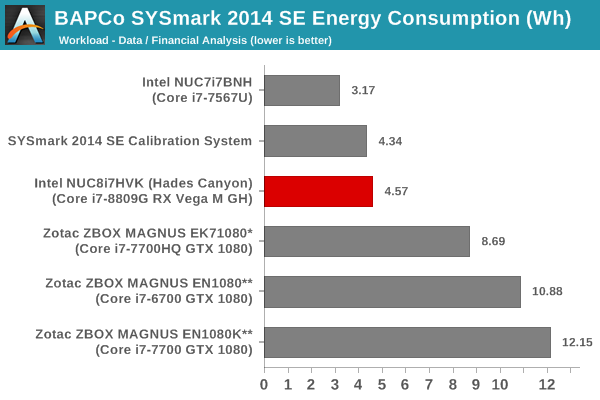

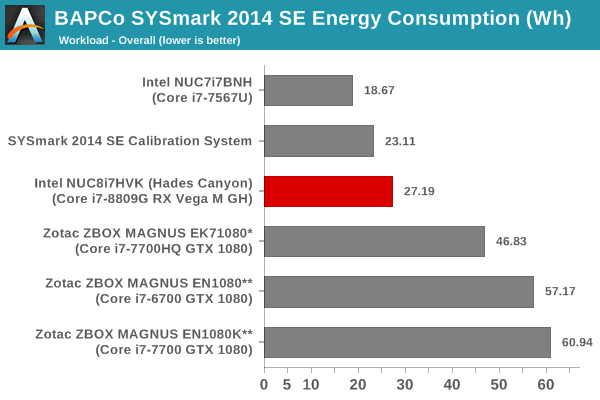
Despite being fully patched for Meltdown and Spectre, the Core i7-8809G manages to outscore the partially patched Core i7-7700HQ-based ZBOX MAGNUS EK71080. It is beat in terms of raw score by the ZBOX MAGNUS PCs using the desktop CPUs (Core i7-6700 and Core i7-7700), but, those PCs consume much more energy to complete the workloads.
Futuremark PCMark 10
UL's PCMark 10 evaluates computing systems for various usage scenarios (generic / essential tasks such as web browsing and starting up applications, productivity tasks such as editing spreadsheets and documents, gaming, and digital content creation). We benchmarked select PCs with the PCMark 10 Extended profile and recorded the scores for various scenarios. These scores are heavily influenced by the CPU and GPU in the system, though the RAM and storage device also play a part. The power plan was set to Balanced for all the PCs while processing the PCMark 10 benchmark.





Futuremark PCMark 8
We continue to present PCMark 8 benchmark results (as those have more comparison points) while our PCMark 10 scores database for systems grows in size. PCMark 8 provides various usage scenarios (home, creative and work) and offers ways to benchmark both baseline (CPU-only) as well as OpenCL accelerated (CPU + GPU) performance. We benchmarked select PCs for the OpenCL accelerated performance in all three usage scenarios. These scores are heavily influenced by the CPU in the system. The results should be analyzed while keeping in mind that most of the comparison systems have scores from the days prior to the release of the Meltdown and Spectre patches.



Miscellaneous Futuremark Benchmarks





3D Rendering - CINEBENCH R15
We have moved on from R11.5 to R15 for 3D rendering evaluation. CINEBENCH R15 provides three benchmark modes - OpenGL, single threaded and multi-threaded. Evaluation of select PCs in all three modes provided us the following results. Here, we see the benefits of running the CPU die with a 65W TDP. The scores match or beat the results from the Core i7-7700 in the ZBOX MAGNUS EN1080K.













124 Comments
View All Comments
ianmills - Thursday, March 29, 2018 - link
I get the form factor but would have been nice to put a couple amd discrete gpus in the benchmarks like a 580versesuvius - Thursday, March 29, 2018 - link
There are mini-PC reviews with discrete GPUs and not a 580 but a NVIDIA GeForce GTX 1080 (8GB GDDR5x) in Zotac ZBOX MAGNUS EK71080.Crazyeyeskillah - Thursday, March 29, 2018 - link
this costs $1700Crunchy005 - Thursday, March 29, 2018 - link
Yeah with a $200 optane drive that is in no way necessary.Samus - Saturday, March 31, 2018 - link
It costs 1000. And that’s retail. It will likely be on sale for 700 in a few months. Adding $80 in RAM and $100 512GB SSD like the drive Mushkin just announced keeps it safely under $1200.$1700 configured price has no influence on the gaming performance of this machine.
sutamatamasu - Thursday, March 29, 2018 - link
What about driver?Intel use default Radeon Software or use custom driver for it? Since the six display goes to GPU
jjj - Thursday, March 29, 2018 - link
So not testing it against any relevant GPU because serving the reader is less important that selling hardware for the modern pseud-press.Typical for AT, God forbid test an ultrabook vs other laptops or a Surface in gaming. Mislead, bend reality to sell the hardware and that's your job. Objectivity, ethics, decency, those are long gone.
ganeshts - Thursday, March 29, 2018 - link
Which part of the 'Gaming notebooks compared' section didn't you read ?ToTTenTranz - Thursday, March 29, 2018 - link
I don't agree with the way the "protest" was made, but the fact is that you guys managed to not compare to a single one of the discrete GPUs that Kaby Lake proposes to compete with (as seen through Intel's own slides about Kaby Lake G): the notebook GTX1060, GTX1060 Max-Q and GTX 1050 Ti.Instead you compared Kaby G with a bunch of 3-4 year-old Maxwell solutions and GP104 discrete cards that are very obviously out of Kaby G's range.
Arbie - Thursday, March 29, 2018 - link
@jjj - Silly rants are supposed to be posted in Wccftech, not here. And mainstream GPUs were addressed: "... the Radeon GPU slotted between the GTX 960 and GTX 980 in terms of performance." If you really need +/- 1 FPS for some specific GPU, there are lots of results here you can use to compare. The question with a box like this is not whether it beats a desktop, but whether it will run advanced games at all. Question answered. Go take your meds.